German postcard by Universum-Film Aktiengesellschaft (Ufa), Berlin-Tempelhof, no. CK-91. Sent by mail in Germany in 1962. Photo: Arthur Grimm.
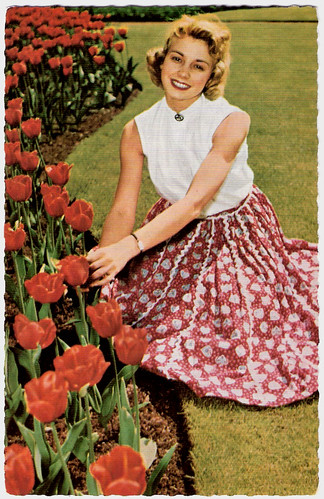
German postcard by Kunst und Bild, Berlin-Charlottenburg, no. CD 1.
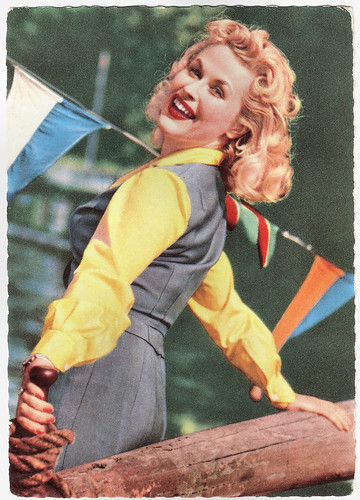
German postcard by UFA, Berlin-Tempelhof, no. CK-92. Photo: Arthur Grimm.
Chance of a lifetime
Bibi Johns was born Gun Birgit Johnsson in Arboga, Sweden, in 1929. There, her father Bertil Johnsson held a trucking business and her mother Anna was a housewife. During her school years, she already performed as a singer under the name of Gun Bertilson. She debuted at 13 years old, in a song competition named 'Children’s Day'. After finishing school she attended at the request of her parents the fashion trade school in Stockholm.
In 1947, she secretly applied for the group Varat Gäng (Our Team) whom she had met years earlier during a concert in her hometown. Varat Gäng was a very popular group in the 1940s consisting of music-talented children and teens, that toured around Sweden playing Swing music. She sang and played clarinet and guitar until the group disbanded in 1948.
During that time she had acquired the stage name Bibbi Johnson. After a few minor appearances, she completed her education at the fashion trade school. Then she joined the trio Yvonne Modin as a guitarist. Finally, she joined Carl-Henrik Norin’s jazz band as a vocalist and recorded her first 78 rpm record in 1949. She was also singing in Thore Swanerud’s jazz band, and the vocal groups The Serenaders and The Metronomers.
In 1951 she made her debut in Germany as a soloist in the entertainment orchestra of the SDR in Stuttgart. Later that year she sang during the Week of light music. An aunt invited her to New York and in 1951, she went to the US on an immigration visa. She started to sing in New York nightclubs and was soon working all over the east US. It was at this point that she started to call herself Bibi Johns on stage.
In 1952, RCA Victor Records offered her a record contract through Gordon Jenkins who supported stars such as Louis Armstrong, the Andrews Sisters, and Dick Haymes. In perfect English, she made recordings of 'The Night Is Filled With Echoes' and 'Someone To Kiss Your Tears Away'. In 1953 she won the TV competition Chance of a Lifetime. The price was 1000 dollars, which she spent on a trip back to Sweden to visit her father for his 50th Birthday.

German postcard by Ufa, Berlin-Tempelhof, no. FK 1647. Photo: T. v. Mindszenty / Central Europa Film / Europa Film. Publicity still for Ball im Savoy/Ball at the Savoy (Paul Martin, 1955).
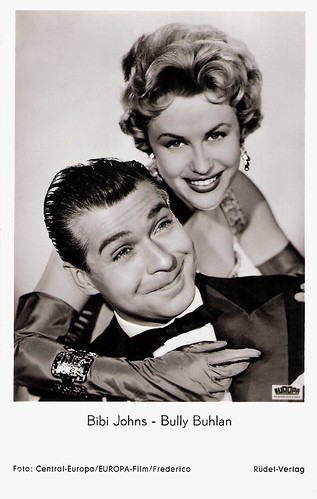
German postcard by F.J. Rüdel, Hamburg-Bergedorf, no. 1313. Photo: Central-Europa / Europa-Film / Frederico. Publicity still for Ball im Savoy/Ball at the Savoy (Paul Martin, 1955) with Bully Buhlan.
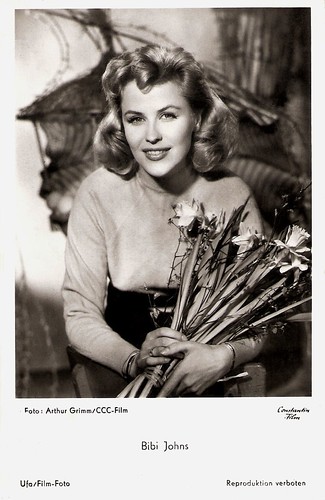
German postcard by Ufa, Berlin-Tempelhof, no. FK 3638. Photo: Arthur Grimm / CCC-Film / Constantin Film.
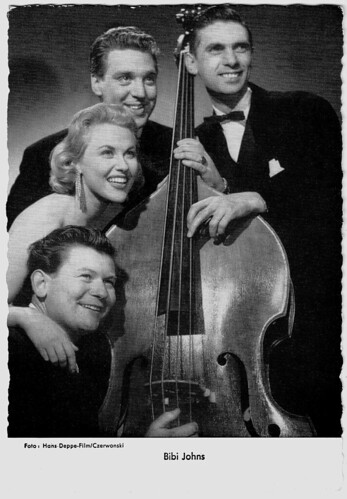
German postcard by WS-Druck, Wanne-Eickel, no. 106. Photo: Hans Deppe-Film / Czerwonski. Publicity still for Tausend Melodien/Thousand Melodies (Hans Deppe, 1956).
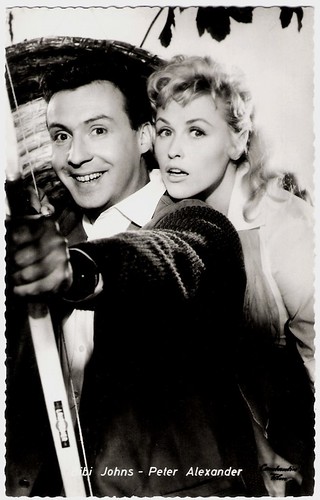
German postcard by Kolibri-Verlag, Minden/Westf., no. 399. Photo: Arthur Grimm / CCC / Constantin. Publicity still for Wehe, wenn sie losgelassen/Beware when she is released (Géza von Cziffra, 1958) with Peter Alexander.
Bella Bimba
In Sweden, Bibi Johns met the German music producer Nils Nobach, who invited her to Germany for a test recording for the Electrola label before she returned to the US. She recorded in German 'Bella Bimba', 'Little Rock/Bye Bye Baby' and her first big hit 'Sehnsucht' (Longing) (1953). That song is now one of the evergreens of the Schlager (the German pop).
In the same year, she made her first film appearance as the lead of the Swedish production Flicka med Melodie/A Girl With a Melody (Martin Söderhjelm, 1954). That year she also appeared in the German musical comedy An jedem Finger zehn/At Every Finger One (Erik Ode, 1954) with Germaine Damar.
She shuttled several times between Europe and the US. From 1954 she also had her permanent residence in Germany. In fact, she was the first in a row of Scandinavian Schlager singers that succeeded in Germany from the late 1950s to early 1970s. Her hits included 'Aber nachts in der Bar' (But at Night in the Bar), 'Zwei Herzen im Mai' (Two Hearts in May), and 'Die Gypsy Band' (The Gypsy Band).
Occasionally Bibi visited Sweden to record songs, e.g. a Swedish version of 'Bella Bimba'. However, she had her biggest audience in West Germany, where she was the star of the 1950s. She made several films including Ball im Savoy/Ball at Savoy (Paul Martin, 1955) starring Rudolf Prack, the comedy Ich und meine Schwiegersöhne/I and My Sons-in-law (Georg Jacoby, 1956) with Grethe Weiser, and Musikparade/Music Parade (Géza von Cziffra, 1956) with Peter Alexander.
She also sang with Erwin Lehn’s Südfunk dance orchestra in Stuttgart. In 1956 when the first German charts were published, Bibi Johns did not celebrate many great successes anymore. That year she participated in Grand Prix Eurovision 1956, the German pre-selection for the European Song Contest, where Lys Assia would be the winner. In 1957 she moved to Polydor, for which she recorded duets with Peter Alexander, such as the hit 'Schon wieder mal' (Again). She also co-starred with him in the musical comedies Liebe, Jazz und Übermut/Love, Jazz and High Spirits (Erik Ode, 1957) and Wehe, wenn sie losgelassen/Beware, When She's Released (Géza von Cziffra, 1958).
German postcard by Filmbilder-Vertrieb Ernst Freihoff, Essen, no. 239. Retail price: 10 Pfg. Photo: Arthur Grimm.
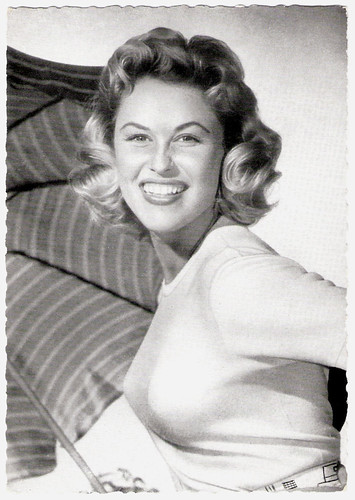
German postcard by Filmbilder-Vertrieb Ernst Freihoff, Essen, no. 153. Photo: Arthur Grimm.
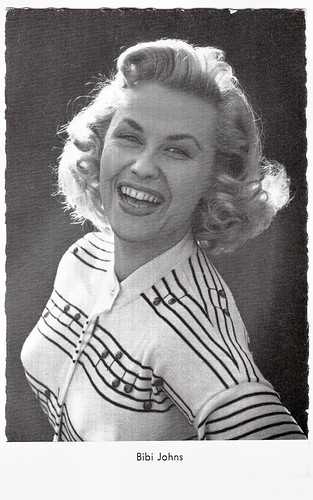
German postcard by Kolibri-Verlag G.m.bH., Minden (Westf.), no. D 12. Photo: Real / Europa Film. Publicity still for Ich und meine Schwiegersöhne/I and My Sons-in-law (Georg Jacoby, 1956).
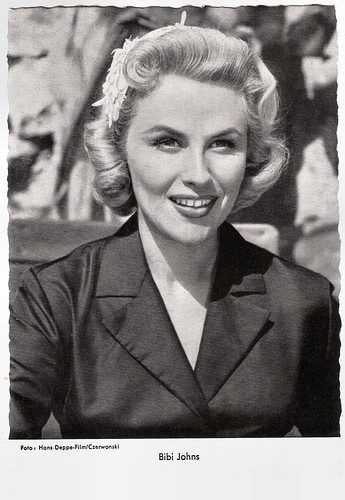
German postcard by WS-Druck, Wanne-Eickel. Photo: Hans Deppe-Film / Czerwonski.
Cult star of the schlager
In the early 1960s, the sales of Bibi Johns’ records subsided somewhat. She returned to Sweden to produce her own stage shows, for tours in the folk parks. For the first time, she now had hit singles in her native country, e.g. 'Leka med elden', 'Bröllopet' and 'Bibi's Bossa Nova'.
In Germany, she was frequently seen in various television shows. She had her own special Kennen Sie Miss Johns/Have You Met Miss Johns? She was directed by her then-husband Michael Pfleghar in the popular TV film Zu jung um blond zu sein/Too Young To Be Blond (Michael Pfleghar, 1961) starring the Kessler twins. Another popular TV film was Paris ist eine Reise wert/Paris is Worth a Trip (Paul Martin, 1966) with Fernandel and Gus Backus.
In 1966 Bibi Johns also competed at the Deutsche Schlager Festival in Baden-Baden, but she didn’t reach the final. In the following years, she appeared often on TV. In 1970 she worked in London as a singer and hostess at the Rolf Harris Show, a coproduction of the German ZDF and the British BBC, and in 1971 she went on tour with pop singer Tom Jones.
One of her last TV appearances was in Der Mann am Klavier/The Man at the Piano (Ekkehard Böhmer, 1985) with Gilbert Bécaud. Till the 1990s, she starred in numerous nostalgia shows and became one of the cult stars of the German Schlager.
In 1975 she decided to try painting and started to study fine arts in Munich. Since then, she has made a career as an artist, exhibiting her paintings around Germany. Bibi Johns was married twice. In the early 1950s, she was briefly married to an American. Her second husband was the film director Michael Pfleghar (1960-1962). Then she lived for several years with the pianist Peter Jacques, with whom she worked in the musical Das Schlüssel-Karussell (The Key Carousel). Between 1974 and ca. 1990 the composer Rob Pronk was her partner. From 1997 till 2010, she lived with the 40 years younger classic pianist Alex Racic. Bibi Johns resides in Pullach, near Munich, in Upper Bavaria.

German collector card in the "Deutsche Filmstars von heute und morgen", series IV.

German autograph card. Photo: Dörte Gröning.
Bibi Johns sings 'Das mach ich mit musik' in Musikparade 1956 (Géza von Cziffra, 1956). Source: Della Street (YouTube).
Bibi Johns sing 'Kannst du schon den Calypso' (1957). Source: Frit51261 (YouTube).
Bibi Johns and Peter Alexander sing 'Vergiß mich nicht so schnell' in Liebe, Jazz und Übermut/Love, Jazz and High Spirits (Erik Ode, 1957). Source: Aschenrind (YouTube).
Source: Bibi Johns Website, Stephanie D’heil (Steffi-line - German), Greg Adams (AllMusic), Wikipedia (German), and IMDb.
This post was last updated on 23 November 2024.
While reading about yet another actor I've never heard of I thought about my minimal exposure to foreign films and came up with two reasons for that: I live in America - and I'm sure there is a limit, based on our own huge film industries - on what would ever get played here. Back in the 40's, 50's and 60's the Catholic Church had much to say about what films we saw. Even a whisper of indecency, a mention of unfaithfulness, a nod to sex before marriage and any evidence of birth control would get a movie a D rating. Which meant eternal death if we saw it. We had a hard enough time finding American movies we could watch.
ReplyDeletegreat stuff Bob, thank you. A talented lady.
ReplyDelete